The anthropogenic influence on the Arctic is unprecedented. Global warming is heating up this pristine ecosystem faster than anywhere else on earth. The heating effect is accelerating because cloud formation, that normally protects the Arctic from high sunlight, is potentially being suppressed. As the Sun warms both the Arctic land surface and ocean, a suite of climate active gases can potentially be emitted (such as methane, carbon dioxide, carbon monoxide), which accelerate global warming. Aerosol particles and other gases such as volatile organic compounds are also emitted into the atmosphere, which have potential feedback effects on the clouds and climate.
Warming of the Arctic may also change the properties of cloud, which could also result in a cooling effect, though the extent to which this may happen is still unclear. Melting sea ice has also opened the area for exploration and new shipping routes. The effect of increased emissions in the Arctic from ships is currently unknown, but it could be that they either suppress cloud formation or promote it.
Many of these questions will be answered using the data collected on DY151.
The Arctic Ocean is highly productive and plays an important role in drawing down and capturing carbon dioxide from the atmosphere. The European Space Agency’s AMT4CO2Flux project is measuring how much carbon dioxide is removed from the atmosphere by the Arctic Ocean and the role that physical processes and phytoplankton play in this.
The project is also developing ocean acidification products using satellite data to provide a long time series of these parameters to assess the health of the Arctic and Atlantic Oceans.
The knock-on effect of the draw down of carbon dioxide from the atmosphere is that increased carbon dioxide in seawater is potentially making it more acidic. Since many of the organisms that live in the sea have calcium-based shells, these conditions could be deleterious or even fatal for them.
I am Dr Gavin Tilstone from Plymouth Marine Laboratory and I head the AMT4CO2Flux project. I boarded RRS Discovery in November 2021 (DY143), but due to complications with COVID-19 during the boarding, the research cruise was cancelled. I was able to participate in RRS Discovery research cruise DY151 during May and June 2022.
A description of the other research activities on DY151 is given below.
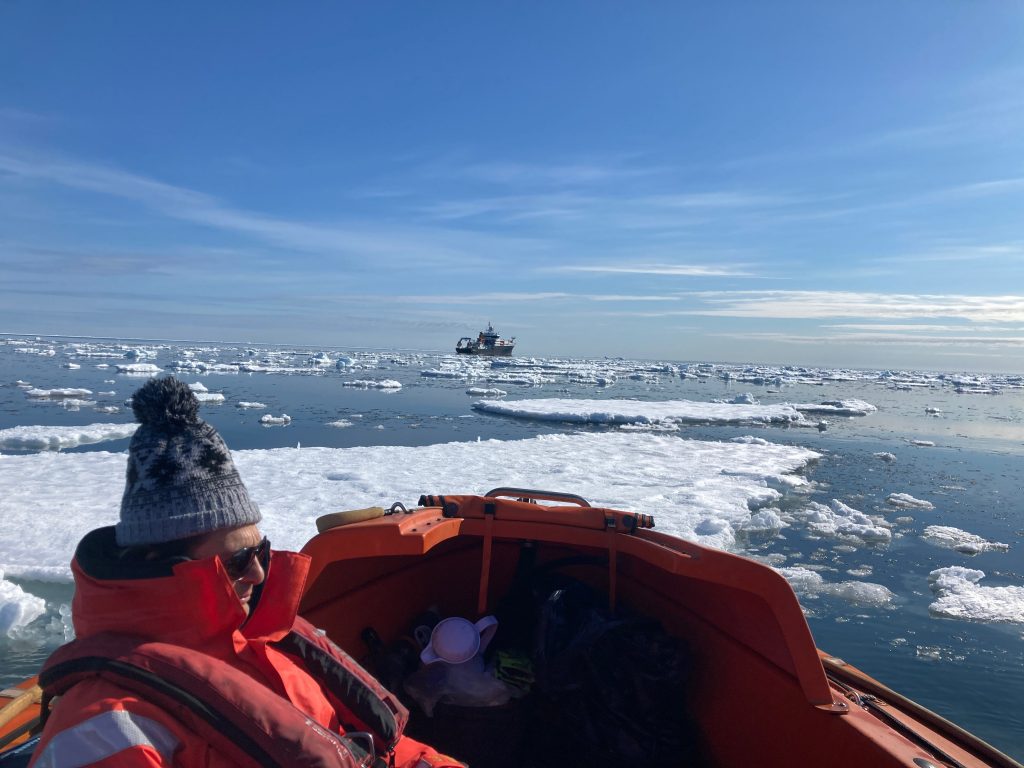
The author, Dr Gavin Tilstone, surveying the sea ice close to Discovery. (PML)
DY151 is an atmospheric research campaign comprised of 18 atmospheric and meteorological research scientists from eight institutes and one oceanographer (the blogger) from Plymouth Marine Laboratory.
The research on the ship is a cross fertilisation of NERC-funded projects. The SEANA project (Shipping Emissions in the Arctic and North Atlantic Atmosphere https://clean-air- research.org.uk/projects/seana/), is researching the potential impact of current and future shipping emissions along the Northwest Passage in the Arctic Ocean and the effect of the changing climate on aerosol, cloud condensation and ice nuclei cloud formation. The M-Phase project (Resolving climate sensitivity associated with shallow mixed phase cloud in the oceanic mid- to high-latitudes; https://cloudsense.ac.uk/m-phase/), is conducting research on aerosol particles, ice-nucleating particles to improve the understanding of their effect on clouds in a warming climate.
Cloud condensation and ice nuclei are tiny particles in the air on which water vapour condenses that accumulate to form clouds. Cloud condensation nuclei are known as cloud seeds and are very small particles on which water vapor condenses to initiate the formation of clouds. In parallel, the increase in shipping in the region is adding more and more sulphur dioxide, carbon monoxide, nitrous oxide and other particles to the atmosphere. These gases and particles can be oxidised in the air and form new particles that may grow to become cloud condensation nuclei. Ice-nucleating particles trigger ice formation in clouds which come from a number of sources and in varying quantities. A combination of these various may increase or decrease clouds which has an impact on how much sunlight reaches the Arctic sea ice and, therefore, how quickly it thaws.
The campaign is headed by Birmingham University under the guidance of Zongbo Shi and his team of eight scientists, who’s have expertise in air quality and atmospheric particles. Zongbo’s research group focus on environmental health, air quality and climate and how particles in the atmosphere and atmospheric processes interact with the biogeochemistry of ecosystems. His field of research has been primarily focused on urban pollution, and this new project is enabling his team to assess how particles and gaseous pollutants emitted from terrestrial sources affect the Arctic and its important ocean. This is his first research voyage on a ship.
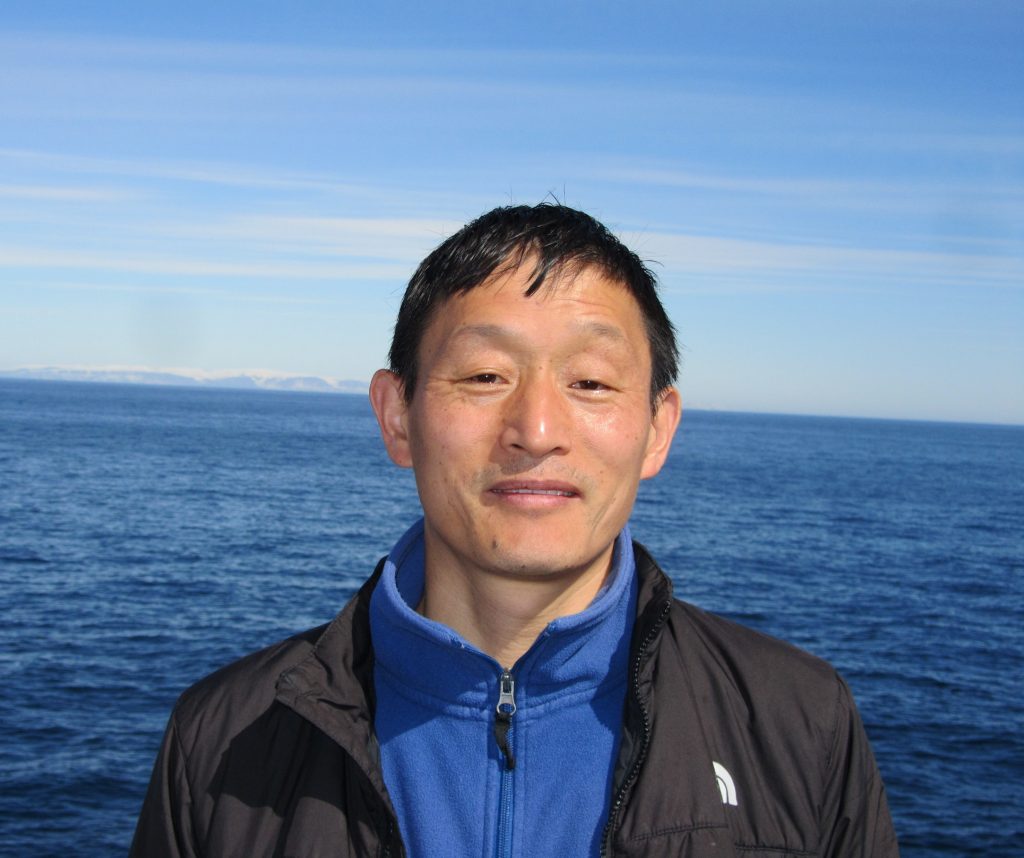
Zongbo Shi on RRS Discovery with ice-capped Greenland in the background. (credits: PML)
As part of Zongbo’s team, Congbo Song maintains a large instrument suite, and together with Mao Du, they measure properties of atmospheric aerosols, including their size and chemical composition, how they form and interact with clouds, which has a knock-on effect to the clouds and climate.
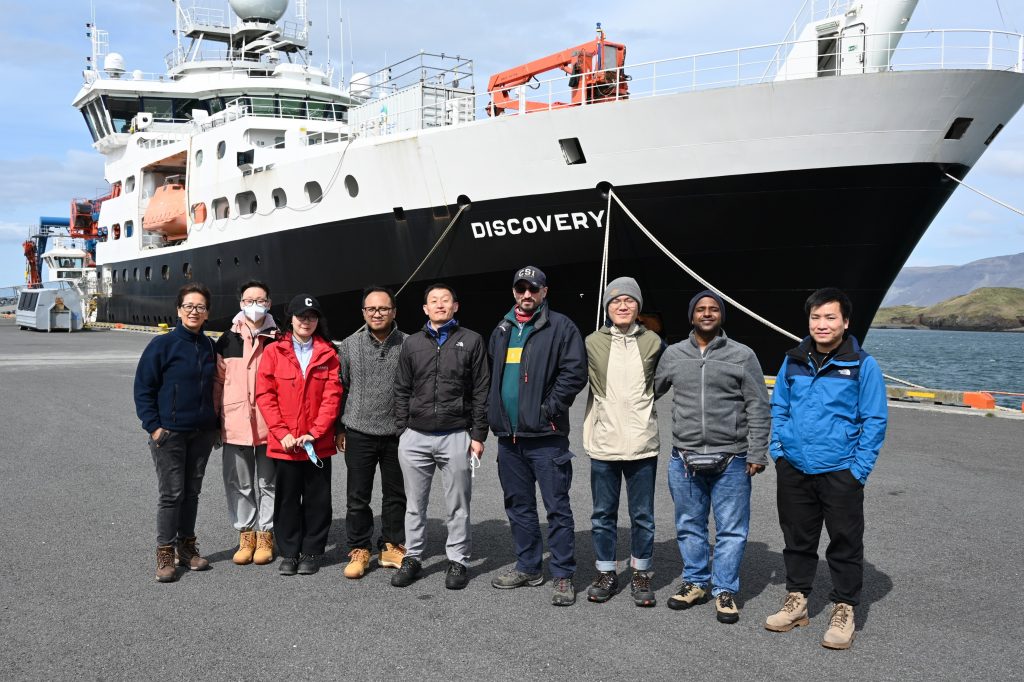
Zongbo Shi’s research team (from left to right): Yangmei Zhang, Xiaomi Teng, Mao Du, Agung Kramawijaya, Zongbo Shi, Roberto Sommariva, Yuqing Dai, Vipul Lalchandani, Congbo Song. (credits: PML)
Agung Kramawijaya at Birmingham University is using atmospheric samplers to measure the composition of heavy metals and organic carbon in the air masses. The atmospheric samplers are rather like large vacuum cleaners that suck in air from the atmosphere, capturing particles on filters. They will be taken back to Birmingham to be analysed by advanced instrumentation in the lab.
Roberto Sommariva is measuring the gas flux of the climate active gases including di-methyl sulphide and nitrous acid.
Yuqing Dai is measuring the measuring greenhouse gases, collecting semi-volatile organic compounds for offline analyses, and supporting the aerosol sampling.
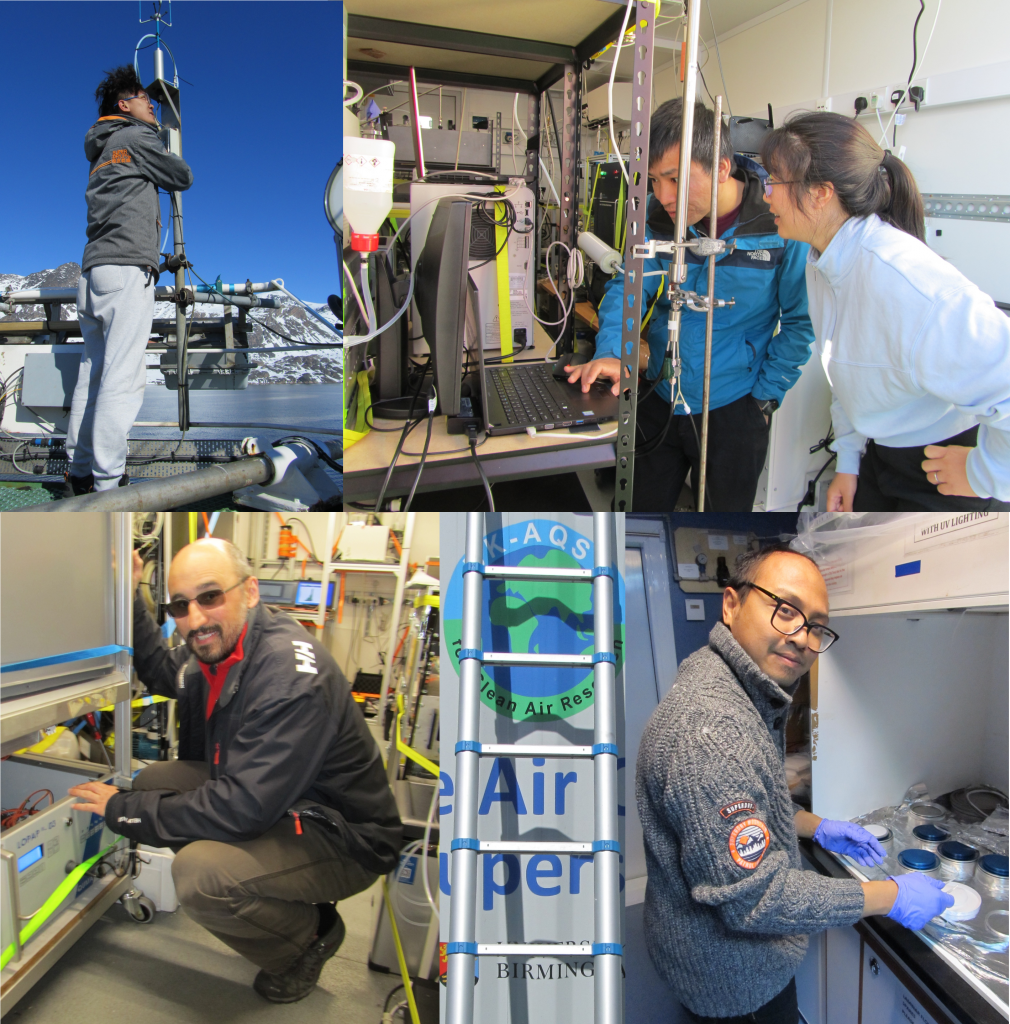
Birmingham University scientists (from top left to bottom right): Yuqing Dai, Congbo Song and Mao Du, Roberto Sommariva, Agung Kramawijaya. (credits: PML)
Three visiting scientists to Birmingham University complement and complete the suite of atmospheric measurements being made. Yangmei Zhang from the Chinese Academy of Meteorological Science, Beijing, is measuring aerosol chemical species to improve the understanding of where the particles come from, how the particles are formed in the atmosphere and how they interact with clouds.
Vipul Lalchandani from the Indian Institute of Technology, Kanpur is also measuring atmospheric particle chemical composition to assess which particles are dominant in the Arctic and what the influence of anthropogenic particles is in the region. After the research cruise, Vipul will join Zongbo’s research team at Birmingham University. Xiaomi Teng from Zhejiang University, China is collecting aerosol particles, which will be analysed by sophisticated microscopy techniques in order to better understand the properties and composition of individual particles and how the sulphate, carbon and iron content of these change as each individual particle interacts with other particles. This has impacts on the air that we breath and therefore implications on human health.
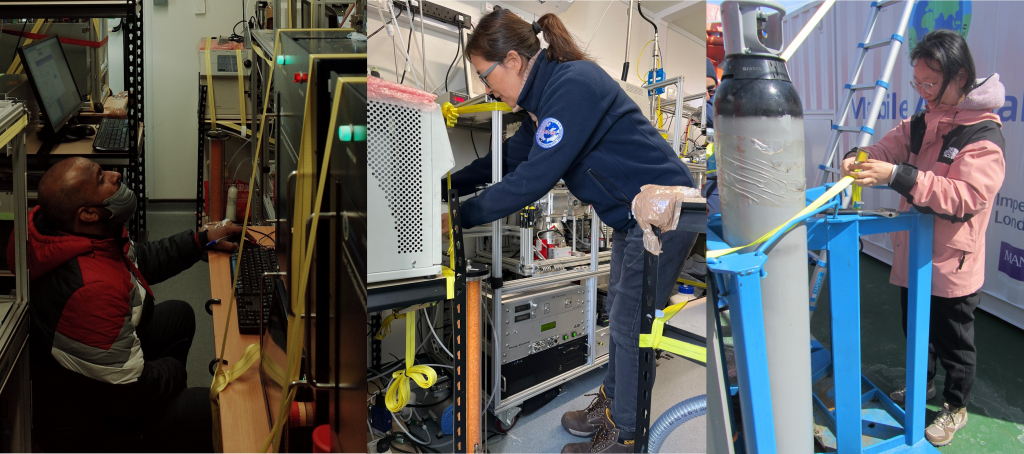
Birmingham University visiting scientists: Vipul Lalchandani, YangMei Zhang and Xiaomi Teng. (credits: PML)
There are two atmospheric scientists from the British Antarctic Survey who work on SEANA. Amelie Kirchgaessner is measuring ice nucleating particles, the temperature at which they activate nucleation and the mass of particles of different size ranges, to determine what type of particles are causing nucleation. Joanna Dyson is studying which aerosols, over a range of sizes (10 to 800 nanomicrometers), form cloud condensing nuclei.
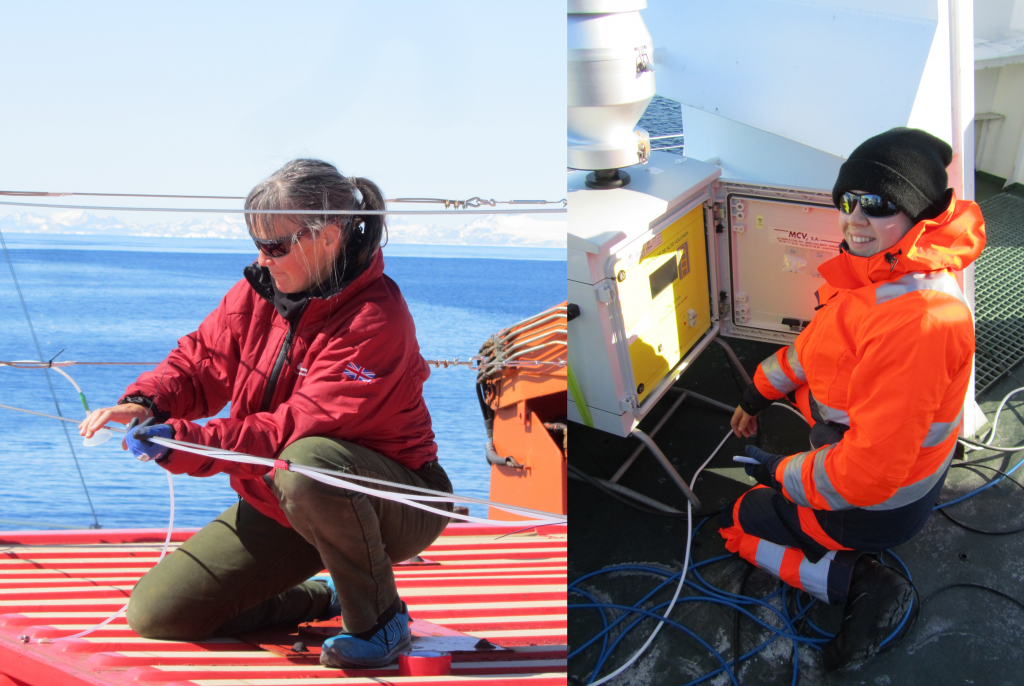
Amelie Kirchgaessner and Joanna Dyson from the British Antarctic Survey. (credits: PML)
Two scientists from the University of York are also working on SEANA. Anna Callaghan is measuring a suite of climate active and ship emission gases which include carbon monoxide, nitrogen oxides, ozone and sulphur dioxide. Loren Temple is using a specialized laser-based instrument to measure sulphur dioxide, at high precision, in the air over the survey region.
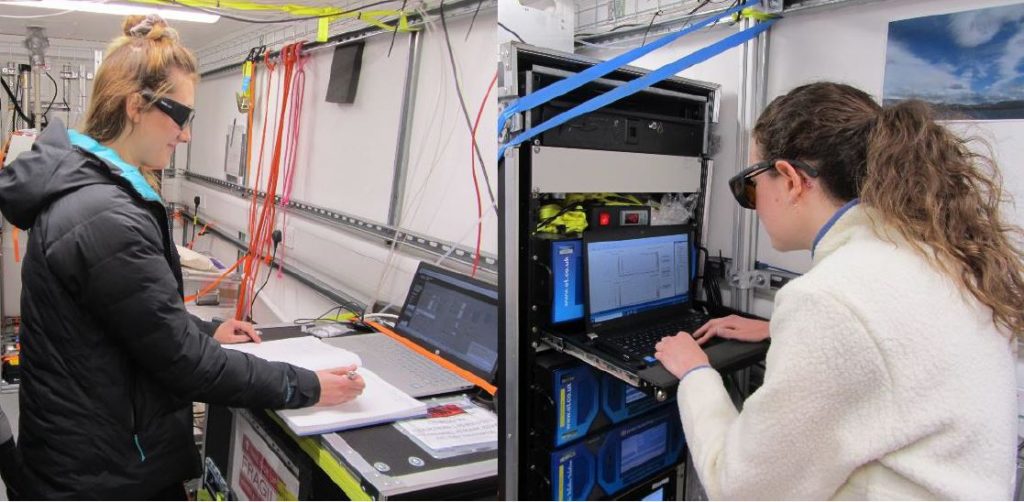
Loren Temple and Anna Callaghan from the University of York. (credits: PML)
Mark Tarn, Sarah Barr, Katie Thompson and Katie Bastin from the University of Leeds work on M- Phase. Their research is focused on the effect of ice-nucleating particles in clouds over the Labrador Sea. As the climate warms, the fraction of ice to water in clouds changes, which in turn changes the reflection of light from the sun back to the atmosphere. As more ice in clouds turns to water, the reflecting properties of clouds increases and so the Arctic may experience a cooling effect. However, this effect may be mediated by the presence of ice-nucleating particles that could trigger freezing in cloud droplets even at the warmer temperatures. The Leeds team are monitoring the concentrations and sources of ice-nucleating particles in the air, but also in seawater to try to understand the contribution of Arctic rivers to these processes.
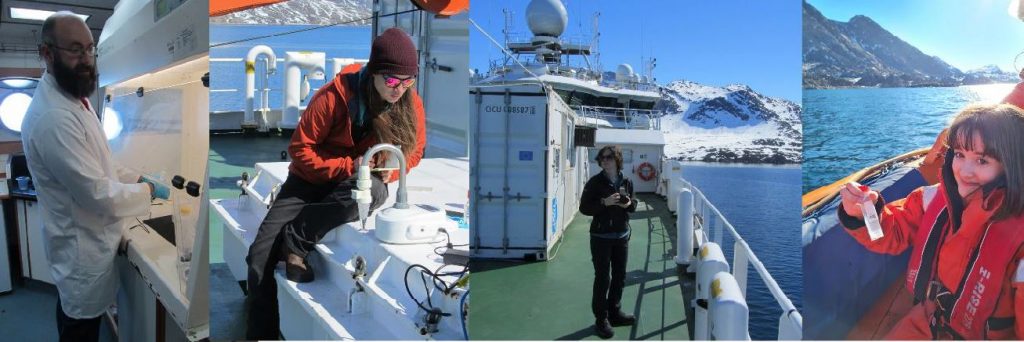
Mark Tarn, Sarah Barr, Katie Thompson and Katie Bastin from the University of Leeds. (credits: PML)
Jo Browse also funded through SEANA is gelling the whole picture together through her atmospheric modelling work. The basis of Jo’s work is that the Arctic is perceived to be changing from a pristine wilderness under the influence of industrialization. Her work on the ship is to quality control, clean and sink the data collected on the ship into one large, easy to use database. Jo’s research modelling will then utilize all of the data collected and integrate it into a larger, pan-Arctic picture, to assess how much the pristine conditions are being impacted by shipping and industrial development. The work she is doing will improve global models and inform the Intergovernmental Panel on Climate Change about the impact that human development is having on the Arctic region as a whole.
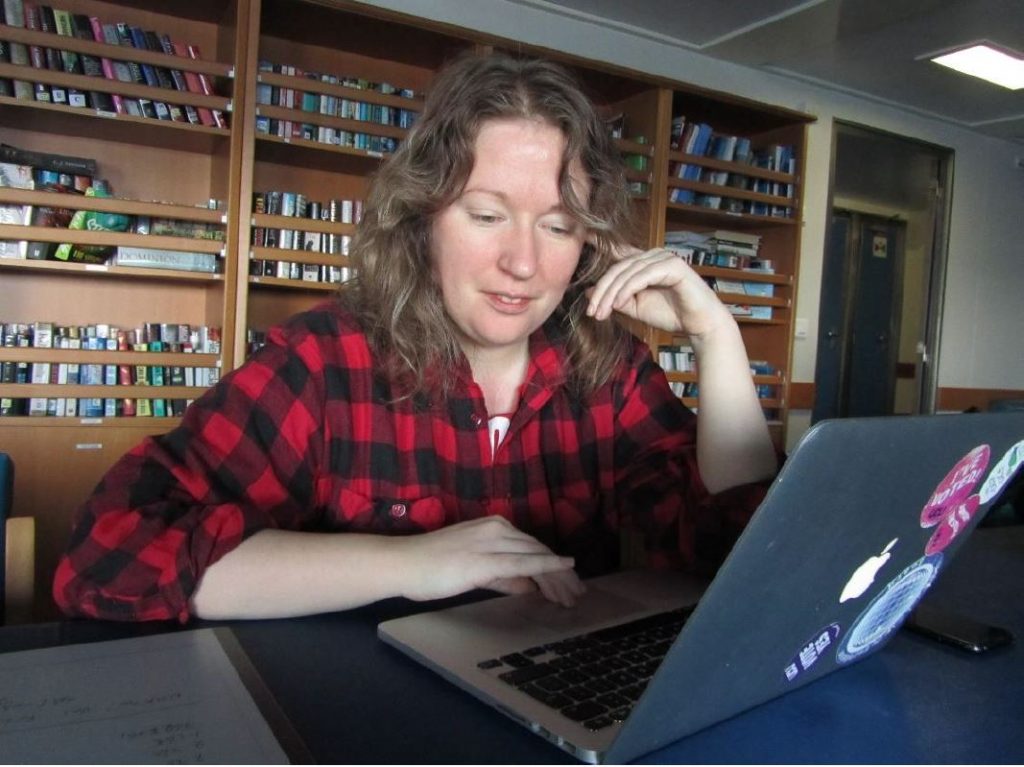
Jo Browse from the University of Exeter. (credits: PML)
On an oceanographic research cruise, all of the equipment used to sample the ocean is deployed by the crew and National Marine Facility technicians from the after deck of the ship. This research cruise is unique in that most of the sampling occurs at the foredeck forward of the ship’s funnel, to prevent cross contamination. On the foredeck there are three specialist built atmospheric sampling containers packed with instruments, plus an array of air samplers located on the roof of the containers and the monkey island near the bridge, which is the highest deck on the ship.
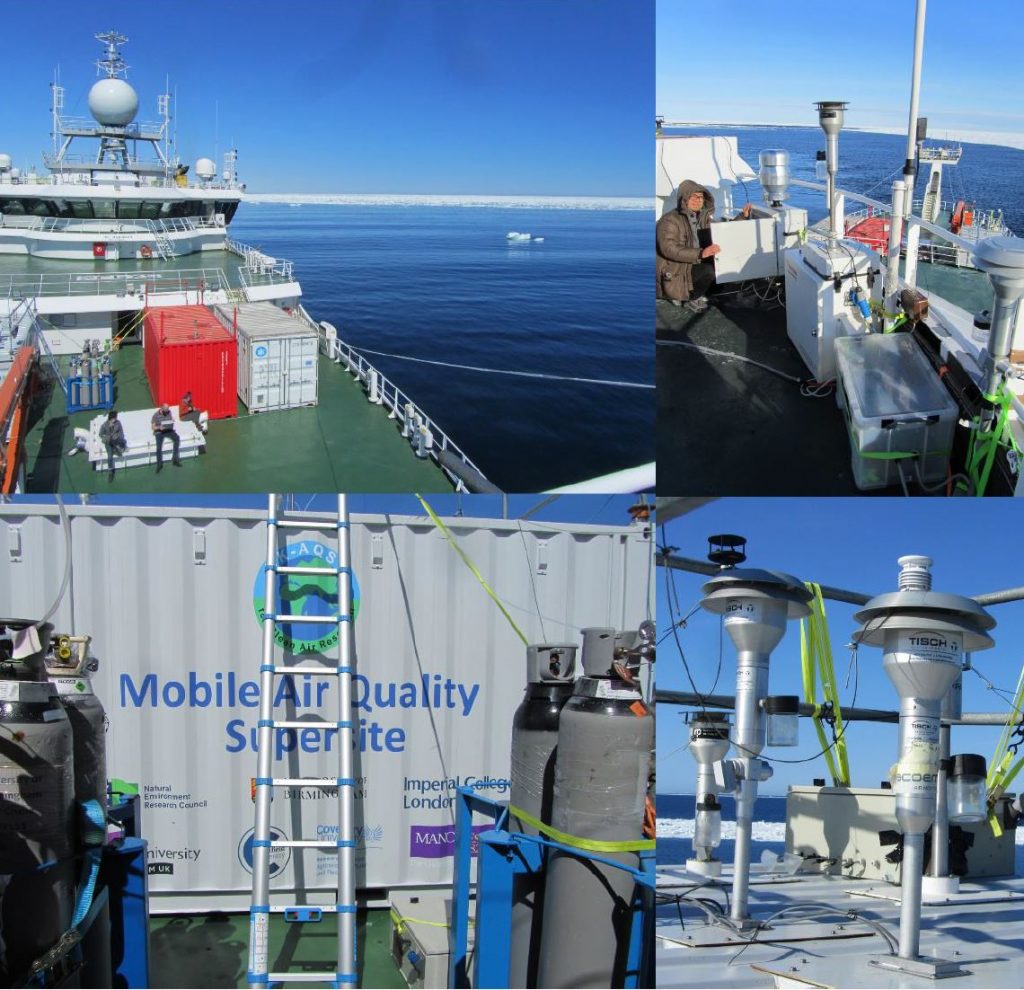
The British Antarctic Survey and Leeds University ice-pod containers (top left), air samplers on the monkey island (top right), Birmingham University air quality container (bottom left) and air inlets on the Birmingham University container (bottom right). (credits: PML)
All of the set-up of this large infrastructure and support to the research on the ship is from three National Marine Facilities (NMF) Technicians. Jon Short the NMF cruise program manager does everything from organizing the logistics during mobilization and demobilization of scientific equipment onto and off the ship (see blog on ‘Mobilisation’), organizing and enabling set-up of scientific equipment, technical support on equipment (especially if it breaks down) all of the health and safety aspects of the campaign from Risk Assessments, Chemical Safety Assessments to the COVID-19 safe protocol for boarding.
Nick Harker provides technical support for the ships scientific systems, and all of the ships instrumentation including the acoustics, multi-beam, swath bathymetry, meteorological and surface underway oceanographic instruments, as well as quality assuring the data, data management, integration and back-up onto the ships data drive.
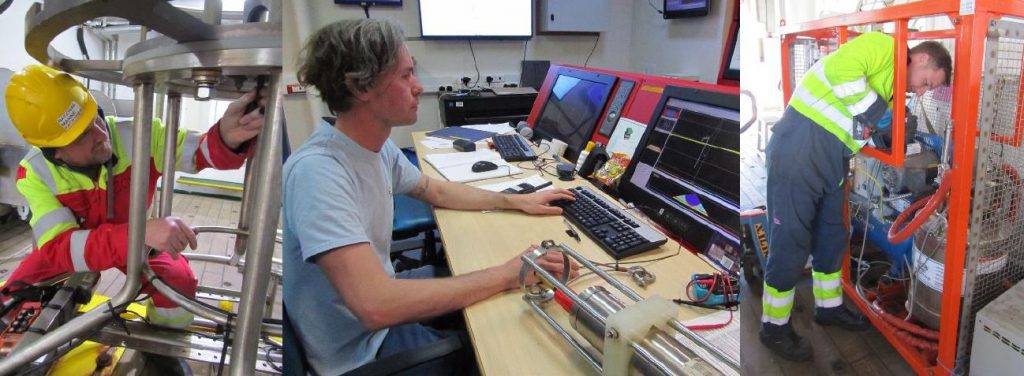
Jon Short, Nick Harker and Jack Arnott (from left to right) of National Marine Facilities, NOC, Southampton. (credits: PML)
Nick is also responsible for the ships system internet and network support for scientist’s laptops and computers to access the ships data. Jack Arnott provides mechanical engineering support for the containers by way of electrical power, water and heating, as well maintaining the liquid nitrogen generator, seawater, pure water and other laboratory supplies. Jack also operates the mechanical engineering workshop to fabricate anything necessary to maintain both scientific and ships instruments.
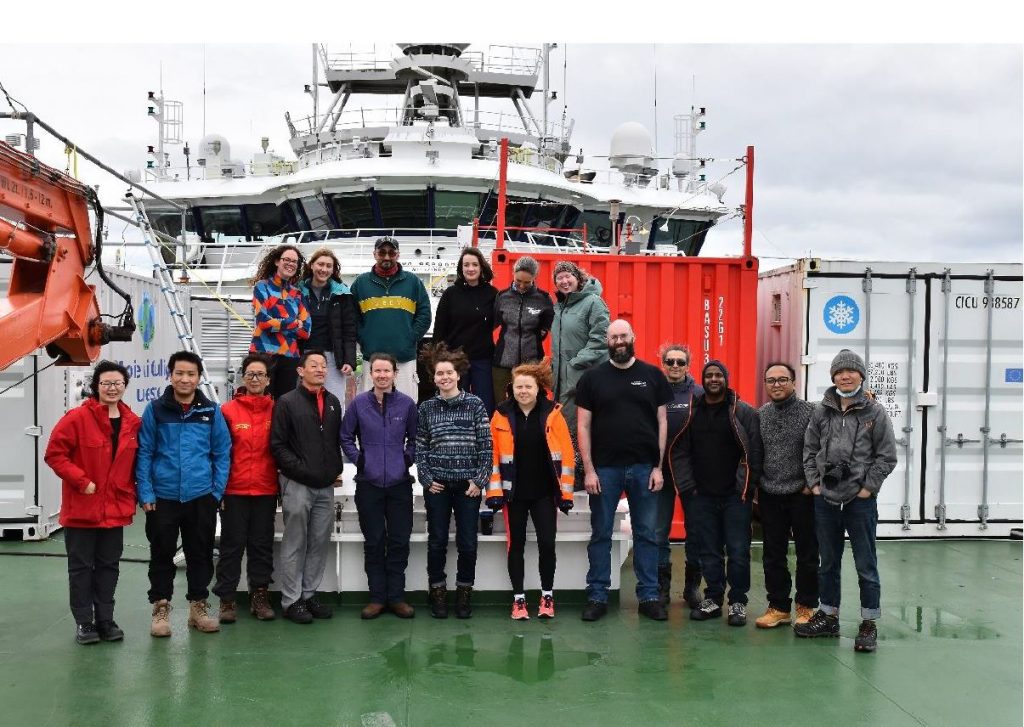
DY151 Science Party. (credits: PML)
Post from: Gavin Tilestone, Plymouth Marine Laboratory








Discussion: no comments